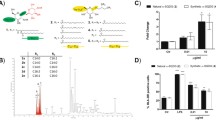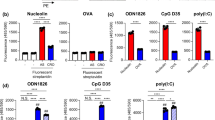Conclusions
The concept of immunostimulatory DNA sequence was born in a long series of studies on BCG-mediated tumor resistance. DNA purified from BCG inhibited the growth of various animal tumors, augmented cell activity and induced IFN from mouse spleen cells. Further, we found two remarkable facts (1) DNA from bacteria, but not animals and plants, showed the above-mentioned immunogical activity, and (2) the activity was completely dependent on particular base sequences having CpG motifs. Research interests of immunostimulatory DNA sequences were galvanized in 1995 by the report of Krieg showing murine B cell activation with bacterial DNA containing CpG motifs [9]. Within a short period of time, a huge number of papers have been published in this field, and the study has expanded rapidly and widely. Now, it includes a number of research fields, for example, host-defense mechanisms against infection, allergy, autoimmune diseases, cytokine networks, plasmid vaccination, and therapeutic application of certain diseases [5, 8, 11, 15, 16, 29]. The response of higher animals against immunostimulatory DNA must be the most primitive but important mechanism for self-nonself discrimination against foreign DNA.
Similar content being viewed by others
References
Adam A, Ciobaru R, Pett J-F, Lederer E (1972) Isolation and properties of a macromolecular, water-soluble, immunoadjuvant fraction from the cell wall of Mycobacterium smegmatis. Proc Natl Acad Sei USA 69:851
Azuma I, Ribi EE, Meyer TJ, Zbar B (1974) Biological active components from mycobacterial cell walls. I. Isolation and composition of cell wall skeleton and component P3. J Natl Cancer Inst 52:95
Baldwin RW, Hopper DG, Pimm MV (1976) Bacillus Calmette-Guerin contact immunotherapy of local and metastatic deposits of rat tumors. Ann NY Acad Sei 277:124
Bird AP (1986) CpG-rich islands and the function of DNA methylation. Nature 321:209
Goodman JS, Van Uden JH, Kobayashi H, Broide D, Raz E (1998) DNA immunotherapeutics: new potential treatment modalities for allergic disease. Int Arch Allergy Immunology 116:177
Hiu IJ (1972) Water-soluble and lipid free fraction from BCG with adjuvant and antitumor activity. Nature 238:241
Kataoka T, Yamamoto S, Yamamoto T, Kuramoto E, Kimura Y, Yano O, Tokunaga T (1992) Antitumor activity of synthetic oligonucleotides with sequences from cDNA encoding proteins of Mycobacterium bovis BCG. Jpn J Cancer Res 83:244
Krieg AM, Love-Homan L, Yi A-K, Harty J T (1998) CpG DNA induces sustained IL-12 expression in vivo and resistance to Listeria monocytogenes challenge. J Immunol 161:2428
Krieg AM, Yi A-K, Matson S, Waldschmidt TJ, Bishop GA, Teasdale R, Koretzky GA, Klinman DM (1995) CpG motifs in bacterial DNA trigger direct B cell activation. Nature 374:546
Lamoureux G, Turcotte R, Portelance V (eds) (1976) BCG in cancer immunotherapy. Grune, New York
Lowrie DB, Tascon RE, Bonato VLD, Lima VMF, Faccioli LH, Stavropoulos E, Colston MJ, Hewin-son RG, Moelling K, Silva CL (1999) Therapy of tuberculosis in mice by DNA vaccination. Nature 400:269
Millman I, Maguire HC, Pass N, Youmans AS, Youmans GP (1976) Mycobacterial RNA: a comparison with intact mycobacteria for suppression of murine tumor growth. J Exp Med 7:249
Millman I, Scott AW, Halbherr T, Youmans AS (1976) Mycobacterial cell wall fractions for regression of murine tumor growth. Infect Immun 14:929
Morton DL, Eilber FR, Holmes EC (1974) BCG immunotherapy of malignant melanoma: summary of a seven-year experience. Ann Surg 180: 635
Pisetsky DS (1996) Immune activation by bacterial DNA: a new genetic code. Immunity 5:303
Sato Y, Roman M, Tighe H, Lee D, Corr M, Nguyen M-D, Silverman GJ, Lotz M, Carson DA, Raz E (1996) Immunostimulatory DNA sequences necessary for effective intradermal gene immunization. Science 273:352
Shimada S, Yano O, Inoue H, Kuramoto E, Fukuda T, Yamamoto H, Kataoka T, Tokunaga T (1985) Antitumor activity of the DNA fraction from Mycobacterium bovis BCG. II. Effects on various syngeneic mouse tumors. J Natl Cancer Inst 74:681
Sonehara K, Saito H, Kuramoto E, Yamamoto S, Yamamoto T, Tokunaga T (1996) Hexamer palindromic oligonucleotides with 5′-CG-3′ motif(s) induce production of interferon. J Interferon Cytokine Res 16:799
Southam CM, Friedman H (eds) (1976) International conference on immunotherapy of cancer. Ann NY Acad Sei 277:60, 94
Terry WD, Yamamura Y (eds) (1979) Immunobiology and immunotherapy of cancer; developments in immunology, vol 6. Elsevier/North-Holland, New York
Tokunaga T, Yamamoto H, Shimada S, Abe H, Fukuda T, Fujisawa Y, Furutani Y, Yano O, Kataoka T, Sudo T, Makiguchi N, Sugamura T (1984) Antitumor activity of deoxyribonucleic acid fraction from Mycobacterium bovis BCG. I. Isolation, physico-chemical characterization and antitumor activity. J Natl Cancer Inst 72:955
Tokunaga T, Yamamoto S, Namba K (1988) A synthetic single-stranded DNA, poly(dG,dC), induces interferon-alpha/beta and -gamma, augments natural killer activity, and suppresses tumor growth. Jpn J Cancer Res 79:682
Tokunaga T, Yano O, Kuramoto E, Kimura Y, Yamamoto T, Kataoka T, Yamamoto S (1992) Synthetic oligonucleotides with particular base sequences from the cCNA encoding proteins of Mycobacterium bovis BCG induce interferons and activate natural killer cells. Microbiol Immunol 36:55
Weiss DW, Bonhag RS, Parks JA (1964) Studies on the heterologous immunogenicity of a methanol-insoluble fraction of attenuated tubercle bacilli (BCG). J Exp Med 119:53
Yamamoto S, Yamamoto T, Kataoka T, Kuramoto E, Yano O, Tokunaga T, (1992) Unique palindromic sequences in synthetic oligonucleotides are required to induce IFN and augment IFN-mediated natural killer activity. J Immunol 148:4072
Yamamoto S, Yamamoto T, Shimada S, Kuramoto E, Yano O, Kataoka T, Tokunaga T (1992) DNA from bacteria, but not from vertebrates, induces interferons, activates natural killer cells and inhibits tumor growth. Microbiol Immunol 36:983
Yamamoto T, Yamamoto S, Kataoka T, Tokunaga T (1994) Lipofection of synthetic oligodeoxyribonu-cleotides having a palindromic sequence of AACGTT to murine splenocytes enhances interferon production and natural killer activity. Microbiol Immunol 38:831
Zbar B, Ribi E, Kelly M, Granger D, Evans C, Rapp HJ (1976) Immunologic approaches to the treatment of human cancer based on a guinea pig model. Cancer Immunol Immunother 1:127
Zimmermann S, Egeter O, Hausmann S, Lipford, GB, Rocken M, Wagner H, Heeg K (1998) CpG oligodeoxynucleotides trigger protective and curative Thl response in lethal murine leishmaniasis. J Immunol 160:3627
Author information
Authors and Affiliations
Rights and permissions
About this article
Cite this article
Yamamoto, S., Yamamoto, T. & Tokunaga, T. The discovery of immunostimulatory DNA sequence. Springer Semin Immunopathol 22, 11–19 (2000). https://doi.org/10.1007/s002810000019
Issue Date:
DOI: https://doi.org/10.1007/s002810000019




